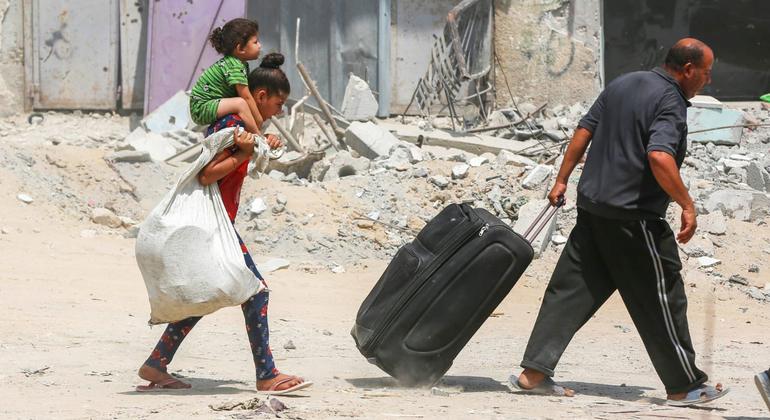Gaza: Thousands flee again after new evacuation order


The directive affects residents in some areas east and central Khan Younis as well as the Al Salqa area of Deir Al-Balah.
According to UN partners monitoring population movements in Gaza, initial estimates show that more than 15,500 people are living in these areas, which cover more than 30 neighborhoods.
Duty to civilians
“Once again, we call on all parties to the conflict to respect their obligations under international humanitarian law, including by taking continued care to protect civilians and civilian objects,” speak United Nations deputy spokesman Farhan Haq speaks at a news conference in New York.
“This includes allowing civilians to leave for safer areas and allowing them to return as soon as circumstances allow,” he added, “everyone must be able to receive humanitarian assistance, regardless of whether they move or stay.”
Water and wastewater restrictions
Meanwhile, the United Nations Office for Humanitarian Affairs, OCHA, speak Palestinians continue to face significant health risks due to restrictions on water production and wastewater pumping in Gaza.
Efforts to scale up water, sanitation and hygiene provision are hampered by a lack of generators and alternative energy sources as well as a lack of spare parts to operate existing generators.
The lack of fuel is also a major challenge, OCHA said. At the end of last month, humanitarian partners supporting water, sanitation and hygiene services reported receiving just over 75,000 liters of fuel.
While that figure is up nearly 30 percent from June, it is still only 70 percent of the minimum operating threshold.
Food distribution disrupted
World Food Programme (World Food Programme) warned that ongoing hostilities, damaged roads and a lack of public order and safety have severely hampered food deliveries in Gaza, forcing food rations to be cut.
WFP is in dire need of fuel supplies, increased food supplies and greater hot meal delivery capacity, particularly in Gaza City and northern Gaza.
The UN agency reached around one million people in Gaza in July, but stressed that food distribution points continued to face major disruptions due to fighting, evacuation orders and damage to infrastructure.
WFP also warned that it would not be able to deliver the necessary amounts of food this month unless more border crossings into Gaza were open and aid workers could reach people safely and on a large scale.
West Bank and Green Line
Back in the West Bank, WFP estimates that escalating violence there could push the number of people facing food insecurity to at least 600,000, up from around 352,000 at the start of last year.
In other developments from the region, the United Nations Interim Force in Lebanon (United Nations) said 10 months of continuous fighting across the Green Line with Israel has displaced, injured and killed many civilians on both sides.
UNIFIL continues to assist displaced people in its area of operation, including providing free medical and dental care to 4,766 patients.
The United Nations has called on all parties to return to the ceasefire and recommit Security Council Resolution 1701.
Adopted in August 2006, Resolution 1701 aimed at ending that year’s war between Israel and Hezbollah. It called for an end to hostilities, the withdrawal of Israeli troops from Lebanon, and the establishment of a demilitarized zone.
De-escalation efforts continue
Later, answering a reporter’s question, Mr. Haq said the United Nations’ efforts to de-escalate tensions in the Middle East were still underway.
He said key UN officials in the region, including Middle East envoy Tor Wennesland, Special Coordinator for Lebanon Jeanine Hennis-Plasschaert and UNIFIL chief of mission and force commander Lieutenant General Aroldo Lázaro “continue to be in contact with the various parties, trying to do what we can to de-escalate”.




